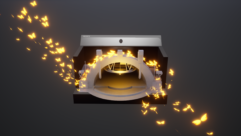A WORLD OF HURT
Dec 1, 2002 12:00 PM,
ALLAN SOIFER
These days everyone talks about communicating by fiber-optic lines as the natural successor to copper wire, or radiated energy. Ever since glass fiber was first used to conduct light in decorative desk lamps from the ’60s, technicians and service staff have had to deal with those pesky, skinny, next-to-invisible strands of glass.
The key word is glass. Think of what happens when you shatter the average windowpane — shards and splinters everywhere. When glass is broken, cut, or cleaved, the resultant fine edges are sharper than your father’s old razor blades. Anyone who has installed pink fiberglass insulation batts in loudspeaker enclosures without gloves and coveralls can attest to the thousands of minute skin cuts that cause intense itching and even massive skin allergies. The glass fibers used in communications are polished on their longitudinal surface, but when you make connections, you must cleave or cut the fiber, and that presents specific safety concerns.
Every time you cleave a fiber, you leave a sharp surface on the standing end and a small, loose piece with two sharp ends. Consider that most fibers being spliced or otherwise serviced are barely thicker than a strand of hair. Put a sharp end on something that thin and you are begging the piece to embed itself under the skin and, possibly, find its way into the bloodstream. Fibers under one’s skin are painful but not at all a permanent hazard. They tend to work themselves out in a day or so — glass is inert by itself — and will not react or infect human tissue. Any infection risk posed is that of material present on the fiber that could be carried into one’s tissues.
A much greater and more deadly risk is that of a small piece of glass fiber finding its way into a blood vessel. Imagine a one-inch-long razor-sharp needle being pushed under 20 to 30 PSI throughout your body (average internal pressure of large arteries). It would be a short matter of time until a vital organ was pierced and damaged. That is an unfortunate reality of the careless handling of fiber-optical material.
Another exceedingly painful and dangerous reality is the potential for a piece of fiber to become embedded in the eye. It’s amazing how easily a tiny glass fiber can find its way from the service bench onto the collar of a shirt or blouse, onto the pillow on your bed, and then into your eye. One wrong turn, and you’re experiencing blinding pain that requires emergency medical attention to avoid permanent damage. The only way to remove those hazards is to receive proper training. Technicians and other handlers must also follow the recommended safety practices at all times.
PROTECT YOURSELF
First, wear a face shield or goggles with wraparound shields to prevent a stray fiber from landing anywhere near the eyes. As a fiber end is cleaved, the breakaway waste piece can fly several feet and land on clothing or hair, completely undetected and invisible. Remember: the glass is transparent and can be seen only against a contrasting dark background with strong foreground illumination. Finger cots and synthetic rubber or compound gloves will go a long way toward avoiding fingertip and palm punctures. The resultant pain of an embedded fiber in the hand is sufficient to prevent one from working for as long as a week while the fiber slowly works its way out of the tissue. The accepted industry practice is to keep a small petri dish or flat, shallow plastic container lined with double-sided adhesive tape. This sticky dish effectively traps the loose cleaved ends and may be conveniently covered and discarded when the adhesive tape is fully covered with fibers. Naturally, one must do the cleaving directly over the dish to derive any safety benefits.
Another overlooked safety hazard is a chemical one. Many hazardous materials are used in the cleaning, preparation, testing, and splicing of fiber-optic material. Various volatile solvents such as iso-alcohol, acetone, thinners, and even ammonia may be found at the workplace. Specialized light-conducting gels and oils are used for temporary test-jig splicing and line testing. Abrasive discs with extremely fine cutting medias are commonplace. All of those mandate gloved hands as well as splash protection for the eyes and body. Inhalation of any of these agents is hazardous, so good ventilation is a must. The solvents can cause brain, liver, and kidney damage upon repeated inhalation of sufficient levels of vapor, and if splashed on the skin, they can cause chemical chapping and even burns.
Now comes what might be the most hazardous but least recognized safety concern with fiber-optic lines — the laser light that is conducted through them. Fiber optics are designed to provide a good optical conduction for laser light at various frequencies. When working with fibers, the service tech must ensure that the laser source is totally de-energized and locked off and that the fiber line is disconnected from the source. Many technicians, who are otherwise scrupulous in their safety standards, forget that the focused energy beam of laser light exiting the fiber has a great deal of power behind it. As the beam impinges upon an object, heat will be produced in proportion to that object’s absorption of the beam.
Human skin and especially eye tissue are remarkably sensitive to burns from even low-level lasers. Even small key chain — type laser pointers can damage eyesight. The laser energy required to send a beam several hundred meters (or more) along a fiber light pipe can do some damage to a careless user. Often, when in a hurry or trying to perform emergency repairs, technicians don’t verify that the line they are servicing is de-energized. As they cleaved, polished, and inspected an energized fiber, people have burned their retinas, blinded themselves in an eye, and suffered multiple laser punctures of hands, arms, and upper bodies. For example, a pulsed laser diode array, used for proving and quality-testing optical splitters and splicing jigs, can deliver as much as the equivalent incandescent power of 10 kW, yet the device is a small box barely larger than a brick of ice cream. The power delivered into the fiber is sufficient to punch pinholes in aluminum cookware; however, some foolhardy technicians prefer to tempt fate and wave the live fiber around like a skipping rope while the pulsed laser array is still energized. Those same idiots then show up at their industrial first-aid center, complaining bitterly about how painful the pinpoint burns are.
When I went on an extensive tour of an optics lab, which featured the best new test gear and safety equipment, I noticed dozens of workstations with uncapped and unterminated fiber cables lying open on the bench. If energized — and there was no direct indication of the on or off state of any of those lines — the cables could have sent invisible laser beams all around the bench area, with enormous potential to grievously injure a passerby.
WAKE UP
This column can’t cover safety measures in great detail — many textbooks do, and your local OSHA should have lots of reference material — but the trade needs an urgent wake-up call. Simply being able to make an acceptable splice joining two fiber-optic lines is not sufficient. This beast has nasty, hidden fangs that can bite without much warning. Injuries mean lost time and revenue, and a careless worker can damage his or her health. Learn about the safety standards and maintain safe handling of fibers at all times. Amateurs should stay far away from fiber-optic systems.
Allan Soifer is an audio engineer and a communications technician who has had more than six years of experience in manufacturing, handling, and installing fiber-optic products without the need for hospitalization or medical attention.










